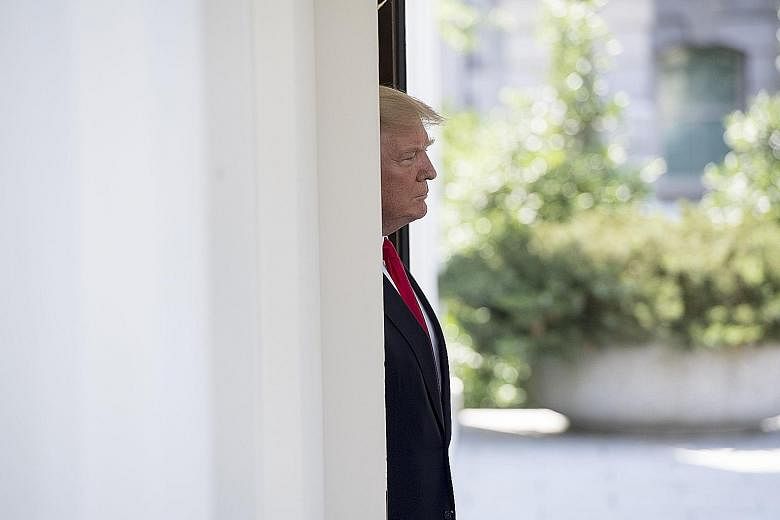No American president sought to charm South-east Asia as much as Mr Barack Obama. Yet his vaunted pivot left the impression that the United States had over-promised and under-delivered.
President Donald Trump can flip that equation. His unorthodox leadership style may extract greater effort on both sides. An America-first mantra will rankle with many. Yet it may also require Asians to shoulder more local security burdens and negotiate fairer trade deals, while prodding the US to replace hoary promises with hard returns on investment.
For the new US policy approach still under review, success will be measured by demonstrable progress on a short list of big wins.
Despite a challenging domestic political transition, the US has striven to reiterate its ascending interests in South-east Asia. During his April visit to Indonesia, Vice-President Mike Pence trumpeted the strategic partnership with the world's third-largest democracy and praised the Muslim-majority country for a tradition of tolerance.
Early last month, Secretary of State Rex Tillerson touted the importance of the half-century-old Asean when he hosted its foreign ministers.
These high-level exchanges may not match the Obama administration's hyperactivity in regional diplomacy. But results matter. With sufficient focus, the Trump administration can showcase real benefits for both the US and its friends in South-east Asia.
President Trump's catchphrase for the region should be simple and durable. US-South-east Asian relations should keep "peace, prosperity and people" at the centre of joint endeavours.

Peace is the indispensable precondition for moving forward. While this region of enormous human and geographical diversity has known its share of war and turmoil, it is relatively tranquil today. But political violence and terrorism, maritime tensions and North Korea's missile programme threaten to spread conflict and thereby transform what should be a bulwark of stability into a sea of troubles.
Working together, the US and regional actors can prevent groups affiliated with the so-called Islamic State in Iraq and Syria (ISIS) from permanently terrorising South-east Asia.
America's military clout can also peacefully support the rule of law, as seen recently through a routine freedom of navigation exercise near the artificially built-up Mischief Reef. And both the region and the world profit when South-east Asian nations think beyond their borders and join the US and others in helping to curb Pyongyang's dangerous nuclear and missile proliferation.
Prosperity is a second pillar of US policy towards South-east Asia. After China and India, the Asean Economic Community has been the region's fastest-rising economy, growing 66 per cent between 2006 and 2015. Last year, its GDP approached the US$2.5 trillion (S$3.5 trillion) mark (three times that in purchasing power parity).
Individual countries offer unique prospects, as suggested by high US foreign direct investment in Singapore, Vietnam, the Philippines and elsewhere. Indonesia alone accounts for more than US$90 billion in total annual bilateral economic relations with the US, and that figure could top US$130 billion by 2019.

America's withdrawal from the Trans-Pacific Partnership has left China in the driver's seat with its Belt and Road Initiative and the Regional Comprehensive Economic Partnership.
Fashioning an alternative long-term geo-economic strategy is vital. But the US administration need not wait for a full-fledged strategy before identifying smart deals.
Specific investments should underscore the US commitment to shared economic growth and job creation: breaking down unfair trade barriers and leveraging America's competitive advantages in areas such as information technology, finance and energy.
People comprise the essential third leg of a Trumpian triad for South-east Asian policy.
While critics of the Republican leadership may prefer to focus on the amount of public funding for foreign assistance, the Trump administration should look afresh at how to focus public-private partnerships where they will do the most good. A decade from now, there should be an exponential growth in the educational, business and military networks of people linking the US and key partners in South-east Asia. People remain the surest bonds that will matter over the long haul.
It is easier to speak about peace, prosperity and people than to ensure their advancement. A Trump administration may leave regional relations in worse shape than it found them. Surely disengagement from the region's security challenges and trade opportunities would accelerate the erosion of America's power and attraction throughout the Asia-Pacific region.
President Trump must either surprise the region by his determination to make his mark or retreat from South-east Asia, thereby leaving it to the arresting gravitational pull of Chinese influence or local divisions.
Fortunately, senior US officials have started down a path for rewarding engagement. Vice-President Pence and Secretary Tillerson took foundational steps.
At the Shangri-La Dialogue, Secretary of Defence James Mattis can reinforce a message of American strength and restraint. After the Secretary of State visits the Philippines in August for the Asean Regional Forum, the stage will be set for President Trump to hammer home broad themes such as peace, prosperity and people.
The White House has confirmed his participation this November in both the East Asia Summit in Manila and the Asia-Pacific Economic Cooperation meeting in Da Nang.
In these, as well as intercessionary talks, the US must keep a laser-like concentration on achieving tangible returns on security cooperation, trade and investment, and benefits for the people of both the US and Asean countries. Whatever "peace, prosperity and people" lacks in ambition or vision can be more than recouped by delivering results.
- Dr Patrick M. Cronin directs the Asia programme at the Centre for a New American Security, a Washington, DC-based national security think-tank .

